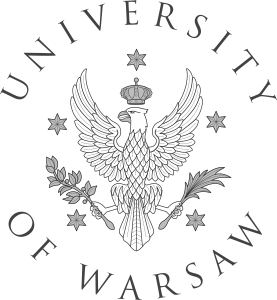Faculty Seminar 11.04.2018
29 marca 2018The Dean of Faculty of Chemistry invites to a FACULTY SEMINAR
on 11th April 2018 (Wednesday) at 15:00 o’clock
in the Old Library (1st floor).
Dr MAREK GRZELCZAK
(Donostia International Physics Center (DIPC), San Sebastian, Hiszpania)
will give a lecture entitled
„Synthesis and Self-assembly of Gold Nanoparticles”.
I cordially invite all the Empoyees, Graduate and Ungraduate Students and everyone interested.
Dr hab. Andrzej Kudelski, prof. UW
Seminar CeNT 29.03.2018
23 marca 2018We would like to invite you to a seminar by Dr. Jeffrey Noel entitled „Toward understanding the dynamin molecular motor: a molecular python”.
The event will take place on the 29th of March at 12pm.
For more details, please see the attachment.
All are welcome.
The Polish scientific consortium PolStorEn
 The official signing ceremony of the Polish scientific consortium PolStorEn agreement was held on February 21, 2018 in the premises of Ministry of Energy. Formation of the Consortium is an expression of cooperation of three sectors: government, science and business in the face of electromobility challenges. The Polish scientific consortium PolStorEn was founded by 6 following universities: Warsaw University of Technology, Poznan University of Technology, Jagiellonian University, Warsaw University, University of Science and Technology, Gdansk University of Technology and one research institute – Institute of Non-Ferrous Metals. Professor Andrzej Czerwiśki (University of Warsaw Faculty of Chemistry) became a President of the Consortium Council.
The official signing ceremony of the Polish scientific consortium PolStorEn agreement was held on February 21, 2018 in the premises of Ministry of Energy. Formation of the Consortium is an expression of cooperation of three sectors: government, science and business in the face of electromobility challenges. The Polish scientific consortium PolStorEn was founded by 6 following universities: Warsaw University of Technology, Poznan University of Technology, Jagiellonian University, Warsaw University, University of Science and Technology, Gdansk University of Technology and one research institute – Institute of Non-Ferrous Metals. Professor Andrzej Czerwiśki (University of Warsaw Faculty of Chemistry) became a President of the Consortium Council.
The main goal of forming this scientific and industrial Consortium is developing and implementing innovative solutions in the field of energy storage with the use of primarily Polish intellectual and economic capital. The organizational structure of the Consortium assumes participation of scientific centres, investments funds and industrial partners interested in the development and implementation of the designed technological solutions.
The PolStorEn Consortium is an essential element to create in Poland a competitive value chain aiming to produce modern battery cells (among others lithium-ion batteries) and super capacitors. It will form a bridge between science and economy. It will unlock the potential of Polish science so that the achievements of Polish scientists could even better serve the economic and social development of the country (partners of the Consortium are in possession of 56 identified solutions in this field that are protected by 31 patents and 29 patent applications both in Poland and abroad). This perfectly fits into the initiatives taken by polish government both on national and European level.
Representatives of Ministry of Energy Ministry of Entrepreneurship and Technology, Ministry of Energy and Polish industry took part in the signing ceremony.

The plans for signing the Consortium agreement had been announced a week earlier by Deputy Minister of Energy Michał Kurtyka in Brussels (link youtube).

Source: www.ch.pw.edu.pl
Discovery of a new fluidic phase

An article on a discovery of a new fluidic phase with a helical structure – SmCTB – has been published recently. The discovery has been made by scientists from University of Warsaw Faculty of Chemistry, University of Aberdeen and a multidisciplinary science laboratory in California – Lawrence Berkeley National Laboratory.
What do liquid crystals and Japan nunchaku have in common? Their structure. Nanchaku is a traditional Japan martial arts weapon consisting of two wooden sticks connected at one end by a chain. Mesogenic materials, which are similar to nunchaku in their structure, are built of two rigid mesogenic moieties linked by a flexible spacer, normally an alkyl chain. Such materials can exhibit a number of fluidic phases that belong to the group of nematics (that are used, for example, to build LCD displays) and smectics (that are characterized by high viscosity and rigidity of the structure due to layer structure).
Scientists from UW Faculty of Chemistry Laboratory of Physicochemistry of Dielectrics and Magnetics – prof. Ewa Górecka, dr hab. Damian Pociecha i dr Mirosław Salamończyk – in cooperation with scientists from University of Aberdeen and Lawrence Berkeley National Laboratory have identified, among smectic phases, a phase with properties that have been unknown so far.
Optical and structural X-ray studies have shown that this phase has a helical structure – over 3-4 layers molecules form a helix (spiral). It’s been the first time when such a structure was discovered in achiral meterials. This means that the scientists have obtained chiral structure out of achiral objects. The helical turn, which is the structural part repeating itself, is just 10-20 nanometers long. The name of the newly discovered fluidic phase is smectic CTB (SmCTB, TB meaning twist-bend).
The studied homologous series has also formed another lamellar phase, so called hexatic I (HexI), which has been known for many years. However, the study has shown that the structure of this phase is not as simple as it has been known so far. Achiral molecules form a double chiral structure on nano– and submikrometer level.
Here you can find out more about the discovery: Nature Communications
Source: www.uw.edu.pl

